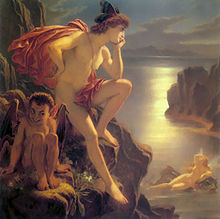Oberon
![]()
This article or subsequent section is not sufficiently supported by evidence (e.g., anecdotal evidence). Information without sufficient evidence may be removed in the near future. Please help Wikipedia by researching the information and adding good supporting evidence.
The figure of the elf-king Oberon (corresponding to Alberich in Germanic mythology) is first found in the French saga Les Prouesses et faitz du noble Huon de Bordeaux from the early 13th century, which belongs to Charlemagne's saga circle.
The material of the poem was later used by many English poets, such as Geoffrey Chaucer, Edmund Spenser, and in William Shakespeare's A Midsummer Night's Dream. Based on this play, Oberon appears as a character in musical theatre works by Henry Purcell (The Fairy Queen) and Benjamin Britten (A Midsummer Night's Dream). In 1787, the newly discovered Uranus moon Oberon was named after the literary character in Shakespeare's drama.
Johann Wolfgang Goethe adopted the characters from Shakespeare's work in the Walpurgis Night's Dream scene of Faust I. Oberon is married to Titania and in Faust I their golden wedding is described.
Christoph Martin Wieland used the character in the 18th century in his romantic epic poem Oberon, after which James Robinson Planché wrote the libretto for Carl Maria von Weber's opera of the same name (see here).
Another well-known author who used this name is Wolfgang Hohlbein. In his fantasy series Anders, the god is called the Elder Oberon.
The term Elf King was derived from the Danish word "ellerkongen". Johann Wolfgang von Goethe took the Elf King as the model for his ballad of the Erlkönig.
_1982,_MiNr_2669.jpg)
Oberon on stamp

Oberon and the Mermaid, Joseph Noel Paton, 1888
Search within the encyclopedia